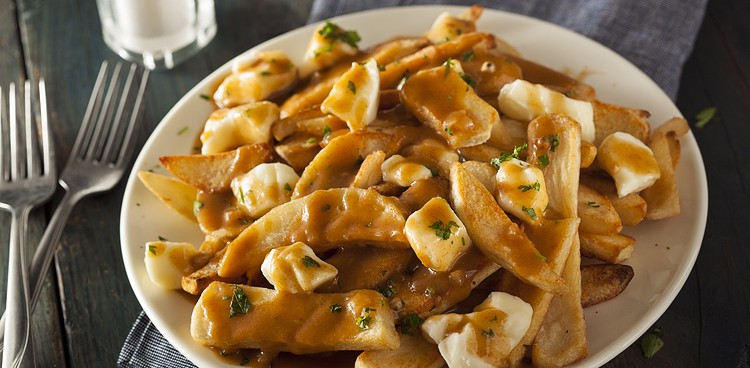
There are endless reasons to travel the world, but one always stands out: food. Get Cultured takes you on a journey through cheesy dishes from different cultures (heyo), exploring how they came to be, what makes them significant, where you can find the real deal, and how you can make your own.
Poutine is as Québecois—and delicious—as it gets. French fries, cheese curds, and gravy come together in this warm, salty comfort food served in dives and diners as well as more upscale joints.
Like many gastronomic origin stories, that of poutine is nebulous, despite being relatively recent. The most widely accepted tale goes like this:
Crottes de fromage, or cheese curds, were a popular snack in Québec in the 1950s—think Cheetos, but more delicious (and louder! Fresh cheese curds make a squeaking sound between your teeth as you bite into them). When trucker Eddy Lanaisse walked into the diner-style restaurant Le Lutin Qui Rit—“The Laughing Hobgoblin”—in Warwick, Québec, one fateful day in 1957, he caught sight of some cheese curds on the counter. Inspired to customize his French fry order, he asked restaurateur Fernand LaChance to throw the two indulgences into a bag together. LaChance curled his lip as he complied, saying, “That’s going to make a hell of a mess.” In French, that’s “Ca va faire une maudite poutine.” Et voila.
The other story goes that in the mid-1960s, Jean-Paul Roy, owner of Le Roy Jucep, another casse-croûte (“greasy spoon”) in Drummondsville, Québec, was serving fries with a sauce (whose recipe remains veiled from the general public today, so the still-in-full-swing resto can keep its gravy close to the vest) and sold cheese curds separately. When he saw diners mixing the two snacks themselves, his menu rose to the occasion, popularizing the famously artery-clogging dish.
Historically, poutine is considered a lowbrow snack. Curds are cheap, fries are cheap, and gravy is cheap. It used to be so déclassé to enjoy this gluttonous snack that in 1991, Québec premier Robert Bourassa literally refused to answer when the CBC asked him if he liked it, abruptly walking away from the podium. I have not seen actual footage of his famous dodge of the question, but I like to imagine it went something like the Seinfeld episode where Jerry submits to a lie detector test about his love of Melrose Place:
“What’s your name?”
“Jerry Seinfeld.”
“What is your address?”
“129 West 81st street.”
“Did Kimberly steal Jo’s baby?”
“I… don’t know.”
These days, humble poutine has evolved into more than diner fare; it’s made its way onto the menus of fancier restaurants and even inspired some specialty establishments of its own. Its heart is still greasy, though, and many Québecois foodies speak fondly of it as a treat to indulge in after several gulps of Crown Royal.

Photo courtesy of La Banquise
The debate over which casse-croûte boasts the best poutine continues without rest, but one destination that shows up again and again on lists of can’t-miss curds is Chez Ashton. A Québec chain that began in 1969 as a food truck, it has since expanded into 25 storefronts in the Québec City area. Chez Ashton keeps its poutine selection simple with just three options: one a classic combination of fries, cheese curds, and brown gravy; one adding ground beef to the mix; and one swapping cheese curds for chicken and peas.
La Banquise in Montréal sits on the other end of the simplicity spectrum with a menu that’s bursting at the seams with creative spins on the dish. Founded in 1968, the snack bar is open 24 hours a day and offers 30 different poutines featuring countless add-ins. I can personally attest to the exquisiteness of La Banquise—it’s decadent, it’s greasy, and I’d admit to loving it on any public broadcast.
And for days when the trek to Québec is too much to manage, there’s no place like home—you can make your own cheese curds for some personalized poutine.
Click here to read all about next week’s cheesy dish of the world, tiropita!
Feature Photo Credit: Brent Hofacker | Shutterstock



